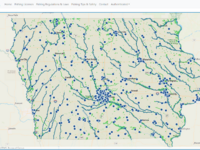On this page...
Welcome to Iowa Trout Country!
Plenty of opportunities await trout anglers in Iowa:
- 50 catchable-stocked rainbow trout fisheries on publicly-accessible streams
- 10 special trout fisheries with restrictive regulations
- 18 community trout fisheries
- More than 50 wild, self-sustaining trout fisheries throughout northeast Iowa
Plan Your Iowa Trout Fishing Adventure
Visit one of Iowa's trout hatcheries during your next trip to northeast Iowa - Manchester, Decorah, or Big Spring. The grounds to each facility are open to the public year round from sunrise to sunset.
Back to topCatchable Trout Streams
The Iowa DNR stocks more than 300,000 catchable-sized rainbow trout in 50 Northeast Iowa streams each year from April through October. More than 600 extra brood trout, weighing over 2 pounds each, are also released in small numbers into each stream. The number of trout stocked into each area varies, depending on length of the stream and how many anglers use the area. These criteria also determine how often each area is stocked.
Surveys show there are still good numbers of trout several days after the most recent stocking and throughout the winter. Along with the stocked trout, many areas have good to excellent numbers of wild brown trout that challenge even the best anglers. Brown trout up to 20 inches are possible.
Trout streams will receive both announced and unannounced stockings. There has been no change to the frequency of stockings or the number of fish stocked at any of our trout streams. Moving to unannounced stockings has given DNR fisheries staff more flexibility in completing the stockings and improving efficiency. This has allowed for improved stream access (mowing) and hatchery maintenance, completing projects around the hatchery and planning for stream improvement projects that they otherwise didn't have the time to complete.
Almost all of the streams in Northeast Iowa have natural reproduction of brown trout and several have natural reproduction of brook trout. Streams with brown trout reproduction have populations that range from 500 to 2,000 fish per mile that rival driftless streams in Minnesota or Wisconsin.
Back to topTrout Hatcheries
View all Iowa fish hatcheries.
Back to topCold-water Stream Fish
Back to topHow to...
- Get a trout fishing license
- Fish for trout
- Clean and cook a fish
- Catch and release fish
- Rod & Reel Cleaning
- Spawning & Fertilization
